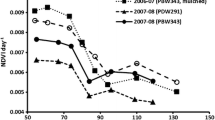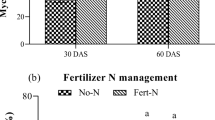Abstract
Blanket fertilizer nitrogen (N) recommendations for large irrigated transplanted rice tracts lead to low N use-efficiency (NUE) due to field-to-field variability in soil N supply and seasonal variability in yield. To achieve high NUE, a fertilizer N management strategy based on visible and near-infrared spectral response from plant canopies using a GreenSeeker™ optical sensor was evaluated. Seven field experiments were conducted during 2005–2007 at two locations in the Indo-Gangetic plains of South Asia to define relationships between in-season sensor measurements at panicle initiation (PI) stage and up to 2 weeks later, and yield of rice. During 2006–2010, seven field experiments were conducted to assess the sensor-based N management strategy and to work out the prescriptive N management to be followed prior to applying sensor-guided fertilizer dose. During 2010 and 2011, the sensor- based N management strategy was evaluated versus farmers’ fertilizer practice at 19 on-farm locations. Relationships with R2 values 0.51 (n = 131), 0.45 (n = 74) and 0.49 (n = 131), respectively, were observed between in-season sensor-based estimates of yield at 42 (PI stage), 49 and 56 days after transplanting of rice and actual grain yield of rice. Applications of 30 kg N ha−1 at transplanting and 45 kg N ha−1 at active tillering stage were found to be the appropriate prescriptive strategy before applying the GreenSeeker-guided dose at PI stage. Sensor-guided N management resulted in similar grain yields as the blanket rate farmer practice, but with reduced N rates, i.e. greater recovery efficiency (by 5.5–21.7 %) and agronomic efficiency [by 4.7–11.7 kg grain (kg N applied)−1]. This study revealed that high yields coupled with high NUE in transplanted rice can be achieved by replacing blanket fertilizer recommendation by an optical sensor-based N management strategy consisting of applying a moderate amount of fertilizer N at transplanting and enough fertilizer N to meet the high N demand during the period between active tillering and PI before applying a sensor-guided fertilizer N dose at PI stage of rice.

Similar content being viewed by others
References
Adhikari, C., Bronson, K. F., Panaullah, G. M., Regmi, A. P., Saha, P. K., Dobermann, A., et al. (1999). On-farm N supply and N nutrition in the rice–wheat system of Nepal and Bangladesh. Field Crops Research, 64, 273–286.
Ali, A. M., Thind, H. S., Sharma, S., & Varinderpal-Singh, (2014). Prediction of dry direct-seeded rice yields using chlorophyll meter, leaf color chart and GreenSeeker optical sensor in northwestern India. Field Crops Research, 161, 11–15.
Aparicio, N., Villegas, D., Araus, J. L., Casadesús, J., & Royo, C. (2002). Relationship between growth traits and spectral vegetation indices in durum wheat. Crop Science, 42, 1547–1555.
Bajwa, S., Mishra, A. R., & Norman, R. J. (2010). Canopy reflectance response to plant nitrogen accumulation in rice. Precision Agriculture, 11, 488–506.
Baligar, V. C., Fageria, N. K., & He, Z. L. (2001). Nutrient use efficiency in plants. Communications in Soil Science and Plant Analysis, 32, 921–950.
Bijay-Singh, Sharma, R. K., Jaspreet-Kaur, Jat, M. L., Martin, K. L., Yadvinder-Singh, et al. (2011). Assessment of the nitrogen management strategy using an optical sensor for irrigated wheat. Agronomy for Sustainable Development, 31, 589–603.
Bijay-Singh, Varinderpal-Singh, Yadvinder-Singh, Thind, H. S., Ajay-Kumar, Gupta, R. K., et al. (2012). Fixed-time adjustable dose site-specific fertilizer nitrogen management in transplanted irrigated rice (Oryza sativa L.) in South Asia. Field Crops Research, 126, 63–69.
Bremner, J. M. (1965a). Total nitrogen. In C. A. Black (Ed.), Methods of soil analysis, Part 2 (pp. 1149–1178). Madison, Wisconsin, USA: American Society of Agronomy.
Bremner, J. M. (1965b). Inorganic forms of nitrogen. In C. A. Black (Ed.), Methods of soil analysis, Part 2 (pp. 1179–1237). Madison, Wisconsin, USA: American Society of Agronomy.
Campbell, J. B. (2002). Introduction to remote sensing (3rd ed.). New York: The Guilford Press.
Cassman, K. G., Gines, G. C., Dizon, M. A., Samson, M. L., & Alcantara, J. M. (1996). Nitrogen-use efficiency in tropical lowland rice systems: Contributions from indigenous and applied nitrogen. Field Crops Research, 47, 1–12.
De Datta, S. K. (1981). Principles and practices of rice production. New York: Wiley.
Dobermann, A., Witt, C., Abdulrachman, S., Gines, H. C., Nagarajan, R., Son, T. T., et al. (2003). Soil fertility and indigenous nutrient supply in irrigated domains of Asia. Agronomy Journal, 95, 913–927.
Dobermann, A., Witt, C., Dawe, D., Gines, H. C., Nagarajan, R., Satawathananont, S., et al. (2002). Site-specific nutrient management for intensive rice cropping systems in Asia. Field Crops Research, 74, 37–66.
Harrell, D. L., Tubana, B. S., Walker, T. W., & Phillips, S. B. (2011). Estimating rice grain yield potential using normalized difference vegetation index. Agronomy Journal, 103, 1717–1723.
IRRI. (1996). Use of leaf color chart (LCC) for N management in rice. Crop Resource Management Network Technology Brief No. 1. Manila, Philippines: International Rice Research Institute.
Johnson, G. V., & Raun, W. R. (2003). Nitrogen response index as a guide to fertilizer management. Journal of Plant Nutrition, 26, 249–262.
Kanke, Y. (2013). Optimizing yield and crop nitrogen response characterization by integrating spectral reflectance and agronomic properties in sugarcane and rice. (Ph.D. Dissertation, Louisiana State University, 2013). Baton Rouge, LA 70803, USA.
Li, F., Miao, Y., Zhang, F., Cui, Z., Li, R., Chen, X., et al. (2009). In-season optical sensing improves nitrogen use efficiency for winter wheat. Soil Science Society of America Journal, 73, 1566–1574.
Ma, B. L., Lianne, L. M., Dwyer, M., Costa, C., Cober, E. R., & Morrison, M. J. (2001). Early prediction of soybean yield from canopy reflectance measurements. Agronomy Journal, 93, 1227–1234.
Meelu, O. P., & Gupta, R. K. (1980). Time of fertilizer N application in rice culture. International Rice Research Newsletter, 5(3), 20–21.
Meelu, O. P., Saggar, S., Maskina, M. S., & Rekhi, R. S. (1987). Time and source of nitrogen application in rice and wheat. The Journal of Agricultural Science, 109, 387–391.
Nguyen, H. T., Kim, J. H., Nguyen, A. T., Nguyen, L. T., Shin, J. C., & Lee, B. W. (2006). Using canopy reflectance and partial least squares regression to calculate within-field statistical variation in crop growth and nitrogen status of rice. Precision Agriculture, 7, 249–264.
Nguyen, H. T., Lee, K. G., & Lee, B. W. (2008). Recommendation of nitrogen topdressing rates at panicle initiation stage of rice using canopy reflectance. Journal of Crop Science and Biotechnology, 11, 141–150.
Peñuelas, J., Gamon, J. A., Fredeen, A. L., Merino, J., & Field, C. B. (1994). Reflectance indices associated with physiological changes in nitrogen- and water-limited sunflower leaves. Remote Sensing of Environment, 48, 135–146.
Raun, W. R., Johnson, G. V., Stone, M. L., Solie, J. B., Lukina, E. V., Thomason, W. E., et al. (2001). In-season prediction of potential grain yield in winter wheat using canopy reflectance. Agronomy Journal, 93, 131–138.
Raun, W. R., Solie, J. B., Johnson, G. V., Stone, M. L., Mullen, R. W., Freeman, K. W., et al. (2002). Improving nitrogen use efficiency in cereal grain production with optical sensing and variable rate application. Agronomy Journal, 94, 815–820.
Shibayama, M., & Akiyama, T. (1991). Estimating grain yield of maturing rice canopies using high spectral resolution reflectance measurements. Remote Sensing of Environment, 36, 45–53.
Sims, D. A., & Gamon, J. A. (2002). Relationships between leaf pigment content and spectral reflectance across a wide range of species, leaf structures and developmental stages. Remote Sensing of Environment, 81, 337–354.
Stroppiana, D., Boschetti, M., Brivio, P. A., & Bocchi, S. (2009). Plant nitrogen concentration in paddy rice from field canopy hyperspectral radiometry. Field Crops Research, 111, 119–129.
Tubaña, B. S., Harrell, D., Walker, T., & Phillips, S. (2011). Midseason nitrogen fertilization rate decision tool for rice using remote sensing technology. Better Crops, 95(1), 22–24.
Tubaña, B. S., Harrell, D. L., Walker, J., Teboth, J., Lofton, J., & Kanke, Y. (2012). In-season canopy reflectance-based estimation of rice yield response to nitrogen. Agronomy Journal, 104, 1604–1611.
Varinderpal-Singh, Bijay-Singh, Yadvinder-Singh, Thind, H. S., & Gupta, R. K. (2010). Need based nitrogen management using the chlorophyll meter and leaf colour chart in rice and wheat in South Asia: A review. Nutrient Cycling in Agroecosystems, 88, 361–380.
Walkley, A. (1947). A critical examination of a rapid method for determining organic carbon in soils: Effect of variations in digestion conditions and of inorganic soil constituents. Soil Science, 63, 251–263.
Wells, B. R., Norman, R. J., Helms, R. S., & Baser, R. E. (1989). Use of plant measurement as an indication of midseason nitrogen fertilization. In W. E. Sabbe (Ed.), Arkansas soil fertility studies, 1988 (Vol. 385, pp. 45–48). Fayetteville, USA: Arkansas Agricultural Experiment Station.
Xue, L. H., Cao, W. X., Luo, W. H., & Dai, T. B. (2004). Monitoring leaf nitrogen status in rice with canopy spectral reflectance. Agronomy Journal, 96, 135–142.
Xue, L., Li, G., Qin, X., Yang, L., & Zhang, H. (2014). Topdressing nitrogen recommendation for early rice with an active sensor in South China. Precision Agriculture, 15, 95–110.
Xue, L. H., & Yang, L. Z. (2008). Recommendations for nitrogen fertilizer topdressing rates in rice using canopy reflectance spectra. Biosystems Engineering, 100, 524–534.
Yadvinder-Singh, Bijay-Singh, Ladha, J. K., Singh, J. P., & Choudhary, O. P. (2007). Enhancing nitrogen use efficiency for sustainable rice-wheat production system in the Indo-Gangetic Plains of India. In Y. P. Abrol, N. Raghuram, & M. S. Sachdev (Eds.), Agricultural nitrogen use and its environmental implications (pp. 139–164). New Delhi, India: I.K. International Publishing House Private Limited.
Yao, Y., Miao, Y., Hunag, S., Gao, L., Ma, X., Zhao, G., et al. (2012). Active canopy sensor-based precision N management strategy for rice. Agronomy for Sustainable Development, 32, 925–933.
Yoshida, S., Forno, D. A., Cock, D. H., & Gomez, K. A. (1976). Laboratory manual for physiological studies of rice. Los Baños, Laguna, Philippines: International Rice Research Institute.
Zhang, J. H., Wang, K., Bailey, J. S., & Wang, R. C. (2006). Predicting nitrogen status of rice using multispectral data at canopy scale. Pedosphere, 16, 108–117.
Acknowledgments
The authors gratefully acknowledge the Indian Council of Agricultural Research (ICAR), New Delhi for providing funds to carry out these investigations under the ICAR National Professor project. We thank Punjab Agricultural University (Ludhiana) and Directorate of Wheat Research-ICAR (Karnal) for providing the necessary facilities used in conducting the experiments.
Author information
Authors and Affiliations
Corresponding author
Rights and permissions
About this article
Cite this article
Bijay-Singh, Varinderpal-Singh, Purba, J. et al. Site-specific fertilizer nitrogen management in irrigated transplanted rice (Oryza sativa) using an optical sensor. Precision Agric 16, 455–475 (2015). https://doi.org/10.1007/s11119-015-9389-6
Published:
Issue Date:
DOI: https://doi.org/10.1007/s11119-015-9389-6




